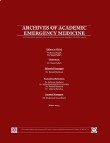Cause of Emergency Department Mortality; a Case-control Study
Author(s):
Abstract:
Introduction
Based on previous studies, cardiovascular diseases, traffic accidents, traumas and cancers are the most important etiology of mortalities in emergency departments (ED). However, contradictory findings have been reported in relation to mortality in emergency departments. Therefore, the present study was undertaken to evaluate the role of clinical factors in mortality among patients referring to an emergency department in a third-level hospital in Tehran, Iran. Methods
In the present case-control study, all the patients over 18 years of age were evaluated, referring to the ED of Imam Hossein Hospital, Tehran, Iran, from the beginning of 2009 to the end of 2010. The patients died in the ED were placed in the case group and those discharged or hospitalized in other hospital wards in the control group. Demographic data, background diseases, and the final diagnoses were recorded. Chi-squared test, multivariate logistic regression, and Pearson’s correlation coefficient were used to evaluate the relationship between the variables mentioned above and patient mortality. Results
A total of 2907 patients (969 (59.9% male) in the case and 1938 (62.2% male) in the control groups) were evaluated. Cardiovascular diseases (39.2%), severe traumas (18.5%), and cerebrovascular accidents (17.7%) were the most frequent etiology of patient mortality in ED. Multivariate regression analysis showed that presentation with cardiovascular complaints (OR=7.3; 95% CI: 3.5-16.1; p<0.001), a history of hypertension (OR=5.4; 95% CI: 1.2-12.3; p<0.001), severe trauma (OR=4.6; 95% CI: 2.0-13.2; p<0.001), age over 60 (OR=3.8; 95% CI: 1.8-7.8; p<0.01) and a final diagnosis of renal disease (OR=3.4; 95% CI: 2.1-6.4; p<0.001) were factors that increased the odds of mortality in patients referring to the ED. Multivariate regression analysis in patients over 60 years showed that sepsis was an independent factor increasing the risk of death (OR=2.9; 95% CI: 1.3-5.9; p=0.009). A patient’s risk of death increases with an increase in the number of risk factors in that patient (r2=0.96; p=0.02). Conclusion
It appears the odds of mortality in patients referring to ED with cardiovascular complaints, a history of hypertensive, severe trauma, age over 60 and a final diagnosis of renal disease are higher versus other patients. In addition, the patients’ odds of death increase with an increase in the number of risk factors. Such an increase is more noticeable at age over 60.Keywords:
Language:
English
Published:
Archives of Academic Emergency Medicine, Volume:2 Issue: 1, 2014
Pages:
30 to 35
magiran.com/p1280799
دانلود و مطالعه متن این مقاله با یکی از روشهای زیر امکان پذیر است:
اشتراک شخصی
با عضویت و پرداخت آنلاین حق اشتراک یکساله به مبلغ 1,390,000ريال میتوانید 70 عنوان مطلب دانلود کنید!
اشتراک سازمانی
به کتابخانه دانشگاه یا محل کار خود پیشنهاد کنید تا اشتراک سازمانی این پایگاه را برای دسترسی نامحدود همه کاربران به متن مطالب تهیه نمایند!
توجه!
- حق عضویت دریافتی صرف حمایت از نشریات عضو و نگهداری، تکمیل و توسعه مگیران میشود.
- پرداخت حق اشتراک و دانلود مقالات اجازه بازنشر آن در سایر رسانههای چاپی و دیجیتال را به کاربر نمیدهد.
In order to view content subscription is required
Personal subscription
Subscribe magiran.com for 70 € euros via PayPal and download 70 articles during a year.
Organization subscription
Please contact us to subscribe your university or library for unlimited access!


